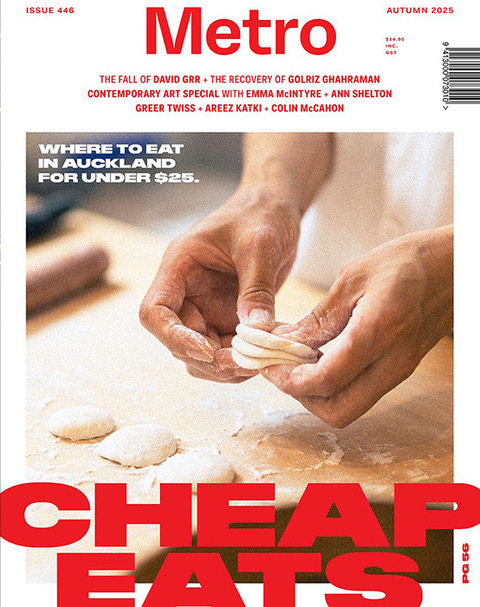Sep 9, 2015 Schools
Are your kids drowning in algebraic frills when they should be doing times tables drills? Chris Barton asks if the way we teach maths is broken – as some international test scores suggest – or simply misunderstood.
This article first appeared in the September 2015 issue of North & South magazine. Chris Barton is a North & South contributing writer.
Wayne Atkins has a real-life recurring nightmare. He’s currently tutoring, privately, a Year 10 student in maths. She’s 13 and doesn’t know her times tables. What does he do? He begins by going online to choose one of the hundreds of times tables games available to get her learning these basic facts. “I’m trying to make it so her experience in the classroom is not completely daunting,” says Atkins, a maths teacher at Marcellin College in Auckland. “It always comes back to the times tables. She is trying to do graphing. She sees, for example, that for every three squares it goes across, it goes up one – a gradient of one third, which is a fraction. But she doesn’t get that.”
He’s come across the same problem often. “I’ve had Year 12 students who have their numeracy credits. I ask them 100×44 and they’ll use a piece of paper.” When children come for tutoring, he’ll often ask them 3×4. “They tell me 12. I ask them a quarter of 12 and they say three. I ask them a third of 12, they say four. I think, thank god, this kid I can teach. But if they say, ‘Oh, I don’t know,’ then I think, okay, we’re going to have to go back to basics.”
At Sir Edmund Hillary Collegiate, a decile 1 school in South Auckland with a predominantly Maori and Pasifika roll, a group of 10- to 12-year-olds – Year 7 – are doing maths, but not as we know it. They’ve been working in deliberately mixed-ability groups of three with plenty of lively discussion on the problem of how many bottles of soy sauce at $7.75 each you can buy with a budget of $441.75. There’s some context, too – it’s Samoan Independence Day and a teacher wants to provide chop suey for all the middle school as part of the celebration.
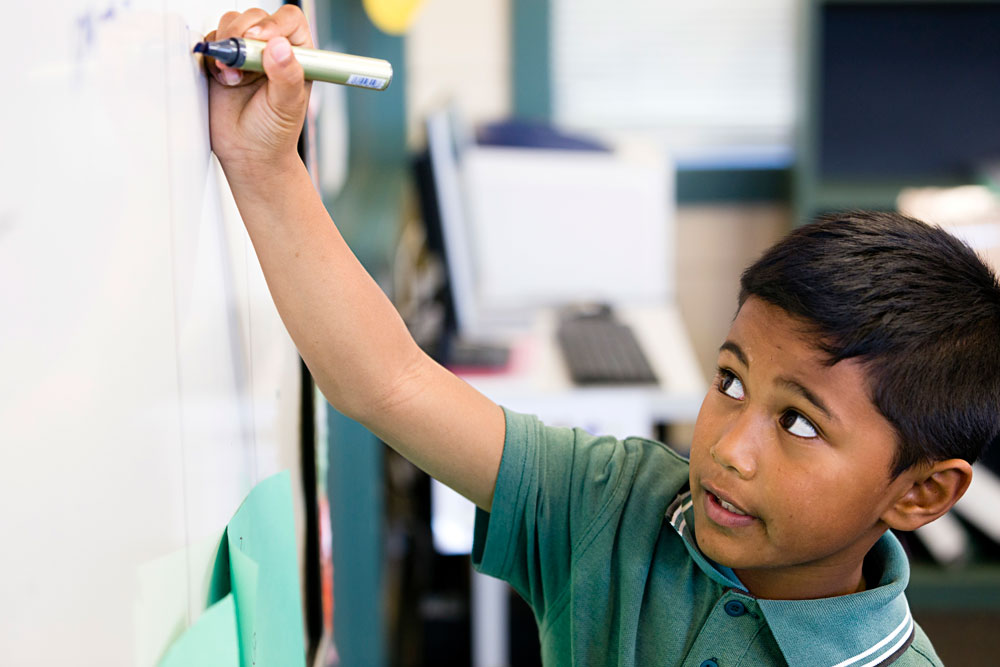
Tohu, Christie and Angel have come up with the answer and are explaining their process to the others. “So we did $7.75 times 10, because that would get us closer to the answer,” says Tohu. The teacher intervenes. “Did you find that explanation very helpful?” The class agrees it wasn’t. “So why 10?” somebody asks. “Yeah, why 10?”
Tohu and his group are pushed to explain that first they rounded $7.75 to $8 and then estimated 50 lots of $8 would get them close. Next, they multiplied $7.75 by 10. Why? Because if they multiplied by 10 first, they could then multiply by five. “Why five?” “Because 10×5 is 50 and we knew our five times tables.” They go on to show how, because they knew their times tables, they could work out that $7.75×50 = $387.50. Next, they subtracted that from $441.75 to see how much money they had left. Then they estimated a couple more times with the remainder – multiplying $7.75x 5 then $7.75x 2 – to reach their answer of 57 bottles.
The teacher asks the class if their parents talk about long division to solve problems like this. “Yes, my dad does,” says one. Others nod in agreement. She goes on to show how the strategy – which the class has not seen before and is dubbed Tohu’s group’s strategy – is essentially a long-division algorithm.
“You learn maths to get better, but I don’t get better. I’ve done maths for years and I don’t get better.”
Here’s what a 10-year-old girl told Massey University professor Glenda Anthony about maths: “You learn maths to get better, but I don’t get better. I’ve done maths for years and I don’t get better.” When asked how maths would help her in the future, the girl replied, “To count money to go to the shop, not for a job, because I can’t do maths.”
Anthony, a specialist in maths teacher education, says it’s a sad story she and her researchers hear far too often. “We hear it over and over with young children whose pathway is decided largely because of the maths class they have been put in – the green group or the pussy cats. In some classes, these children are labelled up on the wall on a ladder.”
As these three anecdotes indicate, teaching maths is a fraught, hotly contested territory of peril and possibility. So while the New Zealand Initiative was surprised by some of the backlash it got in June when it released Un(ac)countable: Why Millions on Maths Returned Little, it shouldn’t have been. The report put forward the view that maths education in New Zealand is in crisis, claiming the cause of the problem is the Numeracy Development Project, a 15-year, nationwide approach for improving maths that the NZ Initiative believes has failed miserably.
Mainstream and social media were awash with comments on both sides of the debate, which became highly politicised. The right-wing think tank copped flak for what many perceived as its disappointingly predictable back-to-basics call and equally predictable teacher bashing.
“It’s really about primary maths teaching. It’s got nothing to do with any left-wing, right-wing conspiracy,” says the Initiative’s executive director, Dr Oliver Hartwich. “Why don’t we look at the way the methods have worked, the results they have produced, and then have a proper debate just on the empirics?”
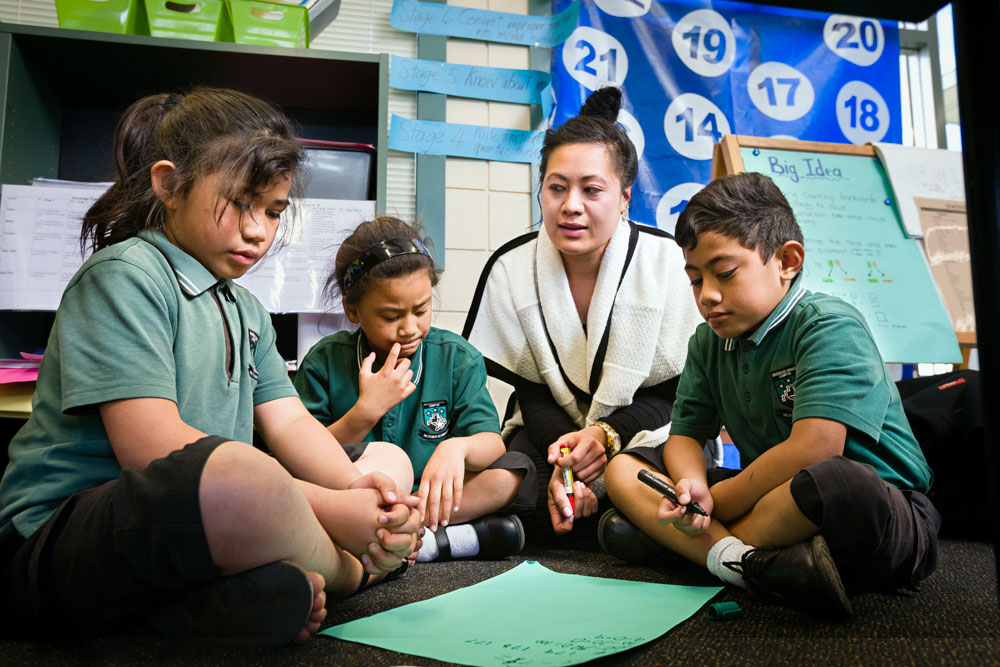
Good idea, but let’s first look at why the New Zealand Initiative is messing in maths teaching in the first place and how its notions of the way that maths should be taught fit with its neoliberal agenda.
The underlying idea is simple enough – that a mathematically competent population is what we need for our 21st-century world, because that will lead to improved economic productivity and financial literacy. It also means more citizens are likely to focus on high-tech, science and engineering jobs, which are seen as the keys to a prosperous knowledge society. For many parents, it’s logic that’s hard to argue with – if their children are good at maths, they’re likely to get good jobs.
Have New Zealand children for the past 15 years been the subject of an unfortunate experiment in maths education?
Putting aside arguments against the neoliberal ideal, which in some eyes leads to an impoverished, profit-obsessed world – or whether maths could be valued simply as something students learn because it’s enjoyable – it’s worth examining more closely “the empirics” of the Un(ac)countable report. And to ask, as this report does, an uncomfortable question: Have New Zealand children for the past 15 years been the subject of an unfortunate experiment in maths education?
The starting point is our Trends in International Mathematics and Science Study (TIMSS) and Programme for International Student Assessment (PISA) results, the benchmarks by which we measure how well children are doing. In short, our maths scores have been gradually falling, although not back to 1995 levels when they were at their worst.
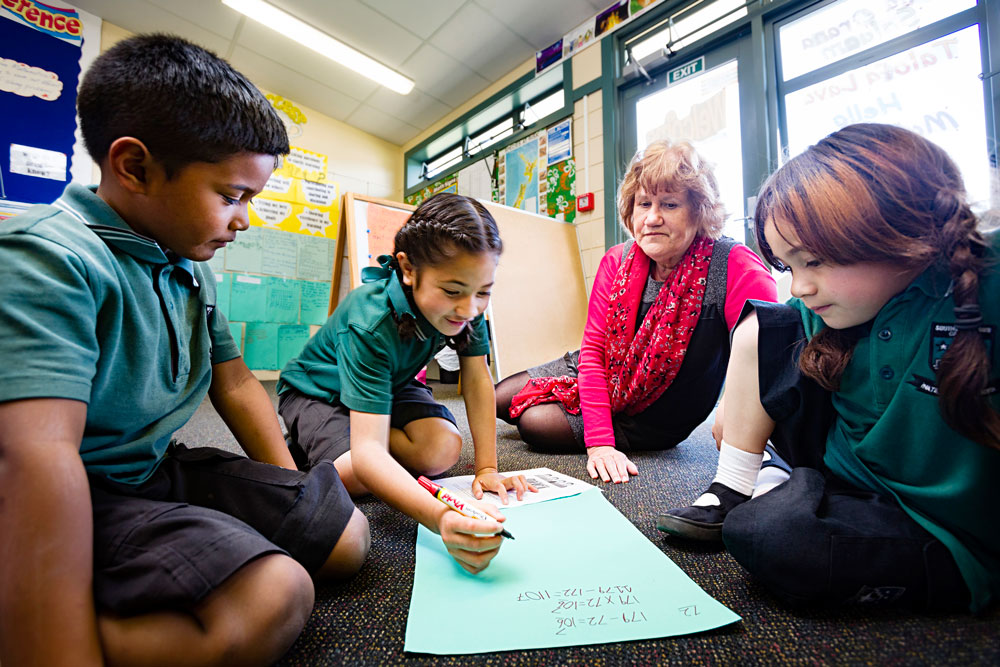
It was those 1995 TIMSS results, coupled with our National Education Monitoring Project (NEMP), that prompted our government to say something must be done about children’s poor numeracy skills. The result was the Numeracy Development Project (NDP), which began as a pilot of an Australian scheme, Count Me In, and was then rolled out to all schools between 2000 and 2010 at a cost of around $7 million a year. In many respects, it was a great idea, giving for the first time primary school teachers throughout the country professional development in the teaching of maths.
Initially, in the early to mid-2000s, the results were encouraging, suggesting gains were being made. But the upswing wasn’t maintained – our numbers on international assessments stagnated and then dropped, and our own NEMP figures showed an alarming drop in the knowledge of basic facts.
Before examining what went wrong, pause for a moment to reflect on what those international benchmarks actually measure. “TIMSS and PISA are hugely valuable bits of data but they have to be seen properly. The very first thing about them that never gets discussed is they do not represent mathematical competence,” says Auckland University mathematics professor Bill Barton. (Yes, he’s my cousin.) “They represent mathematical competence in a very small subset of mathematics; it has to be like that because they can only test what’s at the intersection of all the curricula of all the countries they test.”
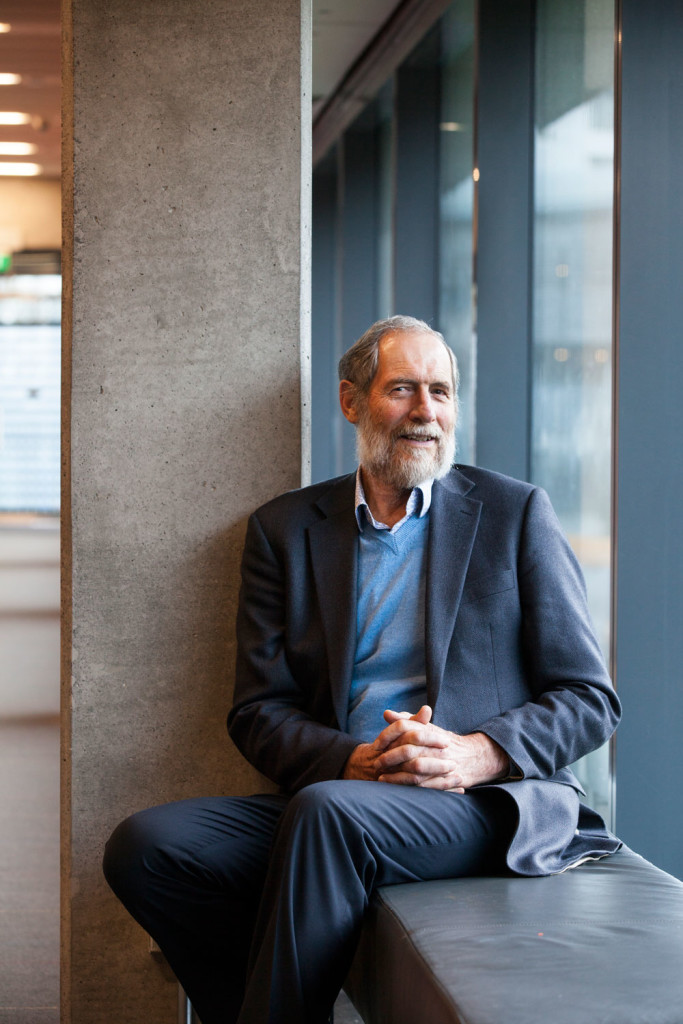
Barton has no doubts about the quality of the data, but says as a comparative tool, it makes very little sense at all. “The conditions in each of the countries are so different, and it’s such a complex picture.” For example, there’s no way of identifying what it is about Finland – a country with a consistently high score – that contributes to its good results.
But TIMSS and PISA do provide a good series of New Zealand data over time, which, in turn, gives a good indication of our rank long-term. For Year 5 students in TIMSS, it shows a score of 469 in 1994 and a score of 486 in 2011, the latter being a drop from a high of 496 in 2002. For Year 9 students in TIMSS, it shows a fall from 501 in 1994 to 488 in 2010. But, as Barton points out, the really significant reading from TIMSS is the large spread of the data – that the distance from our best to worst is very wide, the largest in the OECD.
The Un(ac)countable report makes no mention of this fact, which is odd because while it offers all sorts of advice for improving our maths scores, it doesn’t look at the obvious. Shorten the long tail and New Zealand’s overall results would improve dramatically.
That’s exactly what Associate Professor Bobbie Hunter and other researchers at Massey University are beginning to do at low-decile schools around New Zealand. So far, the programme, known as Mathematics Inquiry Communities, is running in 25 schools and involves around 70 teachers a year doing postgraduate professional development at Massey. But while initial results are encouraging, government efforts in this area have yet to make a significant dent in New Zealand’s long tail of poor mathematics achievement.
When I visit Southern Cross and Edmund Hillary schools in South Auckland with Hunter to see Mathematics Inquiry Communities in action, I’m struck by how engaged the children are – how collaboratively discussing their strategies and then explaining them to the class puts them in control of their maths learning and demands understanding.
At Southern Cross, the seven- to eight-year-olds are well below the national standard, yet they’re engaging with a quite high-level problem: If Mishana had 799 panikeke (Samoan pancakes) and gave 289 to her mum, how many did she have left to sell at the flea market? Once again, mixed-ability groups of three, with one in the group writing the steps down, attack the problem with vigour. Paul’s group takes 200 away from 700 and then 80 away from 90. He explains to the class that nine take away nine is zero.
“Why?” asks Hunter.
“Because it’s the same number,” says Paul.
“That’s a nice ‘because,’” says Hunter. “Paul, can I ask you a question? Is it always going to equal zero if you have the same number taking away from the same number?”
“I think it might be true,” says Paul.
“If I had 13 and I took away 13, how much would I have left?” asks Hunter.
“Zero.”
“Do you want to give me one?”
“Thirty take away 30.”
“What is it?”
“Zero.”
Hunter then talks to the teacher: “That’s a conjecture he just made and you have to be noticing and responding. That’s the foundation of early algebraic reasoning. It’s worth coming back to in another lesson.”
One imagines the New Zealand Initiative might be appalled at the way Hunter is teaching maths, because in many ways it’s similar to what was being advocated by the Numeracy Development Project, which emphasised teachers watching and listening to what children were doing in maths and developing multiple strategies to solve maths problems. In promoting its report, the NZ Initiative made much of the comments of Massey University chemist and distinguished professor Peter Schwerdtfeger, who won last year’s Rutherford Medal: “We are destroying a whole generation of students with these new sociologically inspired methods. The level of maths competence has been in decline for years, and we are having to fix these problems at university.”
The NZ Initiative’s Hartwich says the report itself isn’t opposed to creative teaching, just when that style should be taught. “The new methods have their place and they were certainly well intentioned when they were introduced, but I think the sequence is the key,” he says.
In other words: basic facts first, multiple solving strategies second. “When you don’t even go to the basics – to any prior knowledge of maths, of basic column addition, of basic times tables – then you will struggle to apply these new methods.”
Talk to primary school maths teachers in New Zealand and you won’t find one who thinks basic facts and times tables aren’t vitally important for children to learn. It’s also true to say basic facts and times tables teaching hasn’t disappeared from New Zealand classrooms. So it’s worth questioning Un(ac)countable’s claims that the NDP has eroded this aspect of maths to disastrous effect. There is widespread agreement among mathematics education academics that the NDP was problematic. Most use the term “unintended consequences” when talking about the project. But most also feel the NZ Initiative’s analysis and back-to-basics call are overly simplistic.
Dr Robin Averill, associate dean of Victoria University’s School of Education, points out the NDP didn’t throw the teaching of algorithms (written methods for calculating answers to mathematical questions) or basic facts out the window, but it did bring a different focus. “The focus is on using algorithms once there is the understanding of how the algorithm works. The focus is not learning basic facts blindly without understanding.” Averill, who is a New Zealand representative of the International Commission on Mathematical Instruction, says while the NDP was great for professional development in schools, the downside was its narrow focus on number.
“Some of the other strands – the geometry, algebra, statistics, measurement – have not had as much time in schools as they might have previously. They are really so important for students’ love of mathematics and for their understanding in a wider sense.”
Auckland University’s Barton was critical about the ideology-driven nature of the NDP when it was introduced – that it was focused on the numerate part of mathematics and the way children learn about numbers as a ladder they climb from one step to the next. Barton argues maths isn’t like that. “Learning mathematics is much more like the jungle gyms we had at school. You come in at different directions and you weave back on yourself. The learning of, and the coming to understand, the way numbers work is not a ladder of things.”
He was also critical of the way the NDP taught algebra as generalised arithmetic. “Algebra is basically the abstraction of both geometric and arithmetic ideas. If you want to learn algebra, you have to really grapple with the idea of what abstraction is. Abstraction comes out of having a lot of very different experiences, for example with maps and games, not just arithmetic.”
Barton doesn’t see a return to traditional algorithms as the answer. “Back to basics is simply saying: ‘Oh, let’s forget about everything else. Let’s go back and just do the arithmetic and that’s it.” Argue against such traditional methods and you’re accused of saying mental arithmetic isn’t valuable.
“I’ve always thought mental arithmetic is valuable and every teacher I’ve ever talked to does as well,” says Barton. “But the point is there is so much more we have to be learning to develop in children the kinds of mathematical thinking our society needs – and this is much more than it ever was 50 years ago.”
He’s talking about how maths isn’t something that sits still – the amount of mathematical research doubles every 25 years – and, like so much in today’s world, is influenced and changed by advances in computers and information technology.
Massey University’s Glenda Anthony agrees there should be concern about the performance levels. The fact the massive effort put into a systematic professional development of maths teachers hasn’t translated into an increase in TIMSS results is also disappointing and embarrassing for the Ministry of Education. But she disagrees with Un(ac)countable’s promotion of the need for basic facts first, then the more interesting, creative methods later. “A return to the old days is definitely not the answer. It’s completely against the international research findings,” she says, citing research by Stanford University (California) professor Jo Boaler.
The highest-achieving students were those who thought of maths as a set of connected, big ideas.
This research, using data from the 13 million students who took PISA tests, showed the lowest-achieving pupils worldwide were those who thought of maths as a set of methods to remember and who approached maths by trying to memorise steps. The highest achievers were those who thought of maths as a set of connected, big ideas.
“We very much support procedural fluency and flexibility with numbers,” says Anthony, “but it’s not learned through time tests and speed tests and a lot of practising drill, which can be extremely damaging to young children.”
She’s talking about traditional times tables’ “round the world” learning games where the last one standing is the winner. “Immediately you’re identifying speed with maths ability. It’s a myth that maths people need to be very fast. We have some profiles of mathematicians who are actually quite slow thinkers.”
If the teaching of basic facts isn’t the problem with the NDP, what is? To answer that question, University of Auckland faculty of education lecturer Dr Fiona Ell says you have to ask another: How is it that New Zealand came to have developmental psychology research findings as a basis for its maths curriculum? The answer begins with much excitement about new research of the time, which had found students learned maths best from teachers who understood how they were thinking. In New Zealand, the research was incorporated into the NDP as guidelines for understanding children’s developmental stages in mathematical thinking. It was sent out to teachers as a series of pink books and, for some, became a bible to use almost religiously, says Ell – as “a proxy for the curriculum”.
Somehow New Zealand managed to morph a key diagnostic interview of the numeracy project – designed to help teachers ascertain how advanced students were in their mathematical thinking – into an assessment process. By an even weirder quirk of fate, that assessment process, which determined whether students were additive, multiplicative and ultimately proportional reasoners, found its way first into the New Zealand curriculum and then our National Standards. How? By recognising stages of achievement in terms of the range of strategies used to solve number problems. Hence the curriculum states: “Use a range of multiplicative strategies when operating on whole numbers.”
Bizarre as this may all sound, New Zealand was far from alone in adopting this approach, where mathematics instruction was based on children’s developmental thinking rather than instruction organised by mathematical concepts. “One approach starts from maths and goes down to kids and one starts from kids and builds up to maths,” says Ell. Generally, she says, nations like Singapore that organised their curriculum around the content of maths to be learned, rather than the stages in children’s mathematical thinking, do better on PISA results.
Where things went awry with the NDP was in the way it caused teachers to group children by ability. It began with a diagnostic tool used by teachers to establish the stage children were at. The terminology was awful – early additive, early multiplicative etc. What it meant was whether they were still on addition or had moved on to understand multiplication. Ell says this “ability grouping” probably affected children’s rates of progress. “Teachers tended to give activities that matched where children were at rather than where they were going to.”
Another possible unintended consequence was the NDP abandoned the fundamental concept behind traditional maths teaching – that if you practise lots and lots of times you will derive the concept by doing it lots and lots of times. The NDP, on the other hand, began with teaching the concept and the idea that children didn’t need to do lots of examples if they got the concept.
“In doing that, we’ve lost something we didn’t understand about the role of practice,” says Ell, who is quick to clarify that she’s not talking about rote learning with no understanding. “It’s about practising until you know them [the times tables] off by heart,” she says. “Practice is always going to have a role in mastering a new skill. I think that is something we have lost. What is the role of practice? What is valuable practice?”
Barton also has strong views about the detrimental effects of ability grouping. “The biggest travesty in New Zealand education, and the thing that would make the biggest difference to the spread of our results, would be to completely abolish streaming.” He says that doesn’t mean an individual teacher in a class might not at times group good students together or students who haven’t got the right idea together for periods of time. But it does mean avoiding defining children’s “whole mathematical identity” at a very early age. Barton says once assigned, through a low-ability grouping or low-streamed classes, a child’s mathematical fate is sealed. “The research is you very rarely get out of that identity.”
At Edmund Hillary and other schools around the country, Hunter’s Mathematics Inquiry Communities are paving a different path. “The Numeracy Project got the children to work in staged ability groupings. Those groups are deliberately mixed-ability now, because it is really bad for children’s self-esteem and motivation to be put in a low group,” says Hunter. “We know if you mix up the children, then everyone comes with different pieces of knowledge which, put together, take everybody further.”
It’s a collaborative, mixed-ability approach that has to be done sensibly. “You wouldn’t have somebody who is a gifted mathematician with a child who is really struggling because then neither would learn.” Hunter says the central tenet of giving students a voice requires that teachers rethink and relearn how they were taught. “I think a lot of Pasifika and Maori students are doing really badly because nobody ever hears them.” A key, says Hunter, is noticing children who are very quiet in class and ensuring, as an Edmund Hillary teacher reminds her students, “No passengers get left behind.”
One of the recommendations of the Un(ac)countable report was that a certificate of maths teaching proficiency should be developed, based on a test of both ability and teaching skill. The NZ Initiative’s Hartwich acknowledges many felt this was unfairly focusing all the blame on teachers.
“We pointed out in one of the studies we referenced that a third of teachers had a problem adding two simple fractions,” he says. “That’s not blaming teachers. These teachers might still be motivated and committed teachers in every other way, but it doesn’t change the fact they couldn’t add the fractions.”
Which is why the report suggested such a proficiency scheme should be voluntary. “We didn’t want to put teachers in a corner and blame them for everything – that was never our intention,” says Hartwich. “But at the same time, we see we’ve got a problem with a few teachers who are really not qualified enough to teach these new methods.”
Ell is not impressed. “We often come back to this… that teachers don’t know the maths themselves… the teachers are stupid. I don’t really like that. The teachers are doing their best.” She says the work of Massey University’s Bobbie Hunter highlights a paradox in education.
“Bobbie is a solution – but how do you get hundreds of Bobbies?” And how do you ensure a professional development programme like the NDP doesn’t get sidetracked into “unintended consequences”?
Barton points out that the situation with teachers isn’t new. “Primary school teachers in New Zealand have been drawn from a community that has a large number of people who are insecure with mathematics.” An insecurity, he says, that inevitably gets passed on – either in fear or ignorance, but usually by exclusion. “A teacher who isn’t confident mathematically themselves is going to minimise the amount of time they teach mathematics.”
“There aren’t enough teachers in the country who are confident mathematically at high levels. That’s not their fault, that’s our fault – our fault as a system, as a country.”
Hence teaching in routine ways with books and worksheets because there is no other choice. “There aren’t enough teachers in the country who are confident mathematically at high levels. That’s not their fault, that’s our fault – our fault as a system, as a country.”
Barton identifies other systemic faults: streaming and the constant assessing and ranking that suck the pleasure out of maths. “We are screaming out for students to carry on taking mathematics, yet our system of education imposes things on the students which make it something that’s the last thing you’d ever do.”
Herein lies a dilemma yet to be solved. Do we, as the Un(ac)countable report suggests, opt for more functional mathematics so that our children can add, subtract and understand the percentage interest rate on their mortgage and not borrow money from loan sharks?
Useful stuff and no doubt a pathway to increased economic productivity. But then there are those in primary school education who don’t want to give up on more lofty goals – to teach children to be creative, interested, engaged mathematicians with deep understanding and the ability to see the links and patterns and the connected, big ideas that mathematicians see. That kind of stuff is useful too.
Back at Edmund Hillary, Hunter notices a child not participating in the discussion and asks him a question. There’s no response. “Take a risk,” says Hunter. “If you don’t want to take a risk say, ‘I don’t want to take a risk. Can you ask somebody else?’” At first the child opts out, but Hunter comes back to him a few minutes later. He risks an answer.




